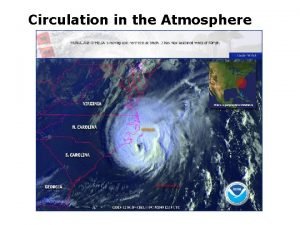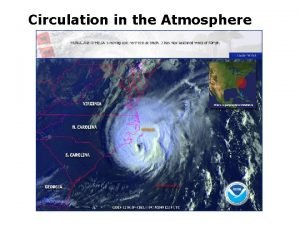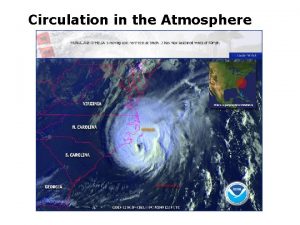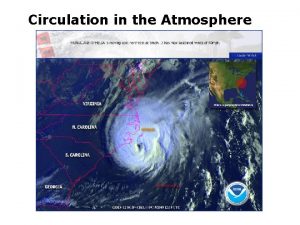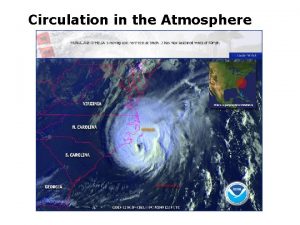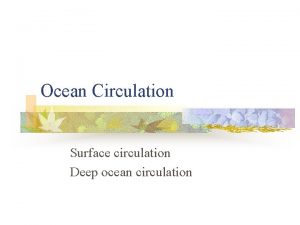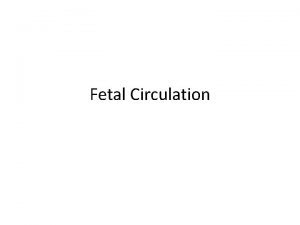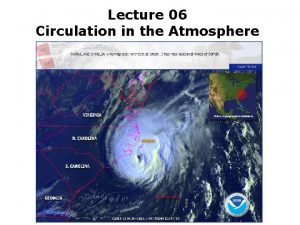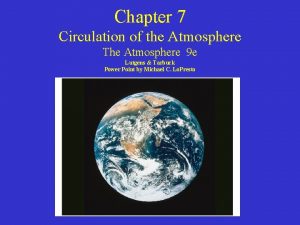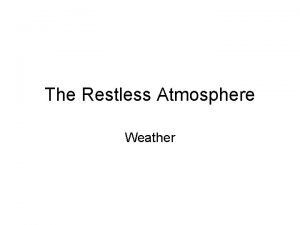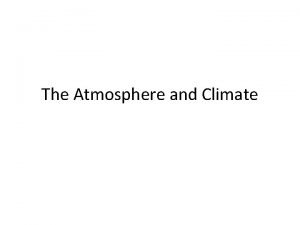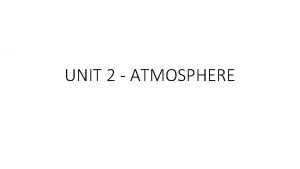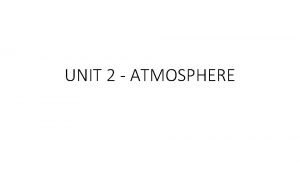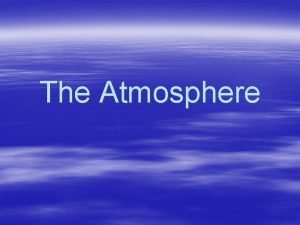Circulation in the Atmosphere Circulation in the atmosphere



















- Slides: 19

Circulation in the Atmosphere Circulation in the atmosphere

What drives the atmospheric circulation? • Two fundamental mechanisms – Differential heating by the sun – Rotation of the planet

Differential Solar Heating From Equator to Poles Incoming solar radiation ~ 1370 W/m 2 X 23

Seasonal Heating

Radiative Budget

Radiative balance • Solar radiation is mostly in the visible band • Earth’s radiation is in infrared band

Reflectivity and albedo • Albedo = fraction of energy reflected – Fully absorbing surface: a = 0 • Black surface ~ sea water – Fully reflecting surface: a = 1 • White surface ~ snow • At high latitudes – Cold ice/snow reflects solar radiation, making it even colder – Positive ice-albedo feedback

Flow of energy in the atmosphere • Net heat gain in tropics • Net heat loss at highlatitudes • Atmospheric circulation is in part driven by the pole -equator differential heating • Atmospheric and oceanic circulations transport heat from low to high latitudes

Vertical motions driven by heating / cooling Heating by the sun AIR PRESSURE troposphere surface Equator/Tropics Higher Latitudes

Horizontal view of air pressure at the surface High Pressure + Higher Latitudes Surfaces of constant pressure y (latitude) x (longitude) _ Low Pressure Equator/Tropics

Fluid accelerates towards low pressure regions

Land-Sea Breeze

Vertical view of air pressure (horizontal convection) High Pressure Low Pressure

Non-rotating view of Atmospheric Circulation Hadley circulation: Tropics

Rotation effect We are in the rotating frame of reference

Tank demo Differentially heated annulus experiment Low lat. “Pole” Low lat.

Differentially heated, rotating flow Baroclinic wave/vortices “Weather events” Look at the IR satellite images http: //www. meteo. psu. edu/~gadomski/SAT_NHEM/atlanim 16 wv. html

Differentially heated, rapidly rotating flow Wave/vortex motion naturally emerges: Mid-latitude cyclones: weather events

Ocean eddies Same mechanism: planetary rotation + temperature gradient
 Alveoli definition
Alveoli definition Single circulation and double circulation
Single circulation and double circulation Single circulation and double circulation
Single circulation and double circulation Thể thơ truyền thống
Thể thơ truyền thống Các châu lục và đại dương trên thế giới
Các châu lục và đại dương trên thế giới Sự nuôi và dạy con của hổ
Sự nuôi và dạy con của hổ Bổ thể
Bổ thể Diễn thế sinh thái là
Diễn thế sinh thái là Vẽ hình chiếu vuông góc của vật thể sau
Vẽ hình chiếu vuông góc của vật thể sau 101012 bằng
101012 bằng Thế nào là mạng điện lắp đặt kiểu nổi
Thế nào là mạng điện lắp đặt kiểu nổi Lời thề hippocrates
Lời thề hippocrates Alleluia hat len nguoi oi
Alleluia hat len nguoi oi đại từ thay thế
đại từ thay thế Vẽ hình chiếu đứng bằng cạnh của vật thể
Vẽ hình chiếu đứng bằng cạnh của vật thể Quá trình desamine hóa có thể tạo ra
Quá trình desamine hóa có thể tạo ra Công thức tính thế năng
Công thức tính thế năng Sự nuôi và dạy con của hươu
Sự nuôi và dạy con của hươu Tỉ lệ cơ thể trẻ em
Tỉ lệ cơ thể trẻ em Dạng đột biến một nhiễm là
Dạng đột biến một nhiễm là




















